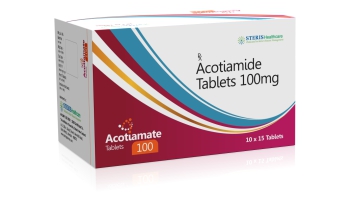Acotiamide 100 mg
Jul 05, 2022
acotiamide 100mg
When it comes to treating indigestion, bloating, and discomfort caused by functional dyspepsia, ACOTIAMATE 100 offers a clinically proven and effective solution. Backed by modern research, this formulation contains acotiamide 100 mg, a gastroprokinetic agent designed to relieve upper gastrointestinal symptoms. If you're looking to understand acotiamide tablets 100mg uses, how it works, and why it's recommended, this article will guide you through everything in depth.
What is Acotiamide 100mg?
Acotiamide tablet belongs to a class of medicines called prokinetic agents. It works by enhancing gastric motility and aiding digestion in patients suffering from functional dyspepsia — a chronic condition characterized by early satiety, postprandial fullness, and upper abdominal bloating or discomfort.
Functional dyspepsia can negatively impact quality of life. Unlike other antacids or acid reducers, acotiamide 100mg acts on the nervous system of the stomach, regulating the release of acetylcholine and thereby improving gastric emptying and reducing dyspeptic symptoms.
Acotiamide Tablets 100mg Uses
Understanding acotiamide tablets 100mg uses is essential for patients facing persistent stomach discomfort. ACOTIAMATE 100 is primarily indicated for:
-
Functional Dyspepsia (FD): The most common indication, where symptoms occur without any structural abnormalities in the GI tract.
-
Postprandial Distress Syndrome (PDS): A subset of FD marked by bloating, fullness, and discomfort shortly after meals.
-
Delayed Gastric Emptying: It stimulates stomach muscle contractions, allowing food to pass faster and relieving sluggish digestion.
-
Non-ulcer Dyspepsia: Especially when patients don't respond to antacids or PPIs (proton pump inhibitors).
How ACOTIAMATE 100 Works
Acotiamide tablet works by inhibiting the enzyme acetylcholinesterase. This leads to increased levels of acetylcholine — a neurotransmitter that promotes gastric motility. As a result, stomach contractions become more coordinated and effective, allowing for proper digestion and relief from bloating, discomfort, and fullness.
Additionally, acotiamide 100mg does not alter acid production in the stomach, making it safer for long-term use without the adverse effects associated with acid suppression therapies.
Dosage & Administration
-
The usual dosage of ACOTIAMATE 100 is acotiamide 100mg, taken three times a day before meals.
-
Swallow the tablet with water. Do not crush or chew.
-
Always follow your physician’s prescribed dosage, especially if you have other gastrointestinal conditions.
Who Can Use Acotiamide Tablets 100mg?
ACOTIAMATE 100 is suitable for:
-
Adults suffering from chronic or functional dyspepsia
-
Patients not responding to conventional antacids or H2 blockers
-
Those with post-meal discomfort, fullness, or belching without ulcers
However, it should not be used without medical advice by:
-
Pregnant or breastfeeding women
-
Children under 18 years
-
Patients with severe liver or kidney disease
Side Effects of Acotiamide Tablet
Acotiamide tablets 100mg are generally well-tolerated. However, some patients may experience mild side effects, such as:
-
Headache
-
Constipation or diarrhea
-
Nausea
-
Increased liver enzymes (in rare cases)
-
Drowsiness
These side effects are usually transient. Consult your physician if symptoms persist or worsen.
Drug Interactions
Acotiamide may interact with:
-
Anticholinergic medications (may reduce its effectiveness)
-
Acid reducers like PPIs or H2 blockers (though not always significant)
-
Medications affecting liver enzymes
Always inform your doctor of all medications and supplements you're taking.
Storage and Handling
-
Store ACOTIAMATE 100 in a cool, dry place below 25°C
-
Protect from direct sunlight and moisture
-
Keep out of reach of children
Why Choose ACOTIAMATE 100 by a Trusted Manufacturer
When you choose ACOTIAMATE 100, you're not just choosing relief from dyspepsia — you're choosing a formulation trusted by doctors and patients alike. Manufactured in WHO-GMP certified facilities, it ensures consistent quality, efficacy, and patient safety.
Unlike random generics, ACOTIAMATE 100 offers:
-
Clinical-grade quality
-
Reliable packaging for stability
-
Patient-friendly pricing
-
Nationwide availability via leading pharmacies and trusted e-commerce platforms
FAQs about Acotiamide Tablets 100mg
Q1. What are the main acotiamide tablets 100mg uses?
A1. It is used to treat functional dyspepsia, especially post-meal bloating, fullness, and upper abdominal discomfort.
Q2. Can acotiamide be used with other digestive medications?
A2. Yes, but only under doctor supervision. Combining with acid reducers or prokinetics should be medically justified.
Q3. How long does it take to show results?
A3. Symptom improvement may be noticed within 1–2 weeks of consistent use. In some cases, longer treatment is needed.
Q4. Is it safe for elderly patients?
A4. Yes, but with proper liver and kidney function monitoring.
Q5. Can I take acotiamide 100mg for gastritis or ulcers?
A5. No, it is not meant for ulcer-related dyspepsia. It is specifically for functional (non-ulcer) dyspepsia.
Conclusion
If you're experiencing persistent post-meal bloating, heaviness, or digestive discomfort without an underlying ulcer or structural issue, ACOTIAMATE 100 can offer you a clinically effective and well-tolerated solution. With its targeted action and minimal side effects, acotiamide tablets 100mg represent a modern approach to functional dyspepsia management. From improved gastric motility to better quality of life, this therapy is fast becoming a preferred choice among gastroenterologists.
Whether you're exploring treatment options or seeking to understand acotiamide tablets 100mg uses in depth, ACOTIAMATE 100 is a name that promises safe, reliable relief with scientific backing.
Recent Post

Steris Healthcare Pvt Ltd Radiates Excellence at the Dec 2025 ZEE Media Global Innovation & Leadership Summit, London!

Terbinafine 250mg & Itraconazole 100mg: The Ultimate Solution for Stubborn Fungal Infections Steris Healthcare.

Understanding Nebivolol 5mg & S-Amlodipine 2.5mg: A Powerful Combo for Heart Health

FLAVOSHIELD 500: The Complete Guide to Micronized Purified Flavonoid Fraction for Venous Health Steris Healthcare.

Unlocking Relief: How Egolix 150mg Treats Endometriosis Pain Steris Healthcare.

Isosorbide Mononitrate 60 mg in Long-Term Angina Management: Role and Best Practices Steris Healthcare.

How Ribavirin Capsules Help in Treating Chronic Viral Infections Steris Healthcare.

Mefenamic Acid With Paracetamol Suspension Effective Relief for Pain and Fever in Kids Steris Healthcare.

Levosalbutamol and Ipratropium Bromide Respirator Solution Quick Relief for Wheezing & Tight Airways Steris Healthcare.

Levosalbutamol Respiratory Solution 0.31 mg Trusted Relief for Breathing Problems Steris Healthcare.

